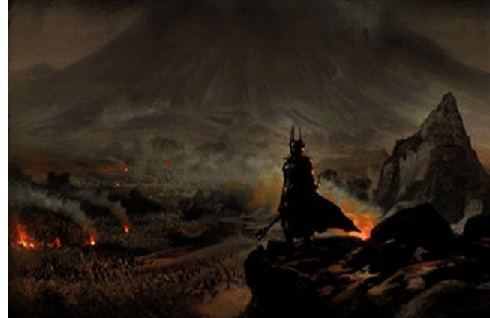 | ||
The war of wrath silmarillion
The War of Wrath, or the Great Battle, a key plot development in J.R.R. Tolkien's legendarium, is the final war against Morgoth at the end of the First Age.
Contents
- The war of wrath silmarillion
- The Silmarillion account
- The History of Middle earth accounts
- Impact on popular culture
- References
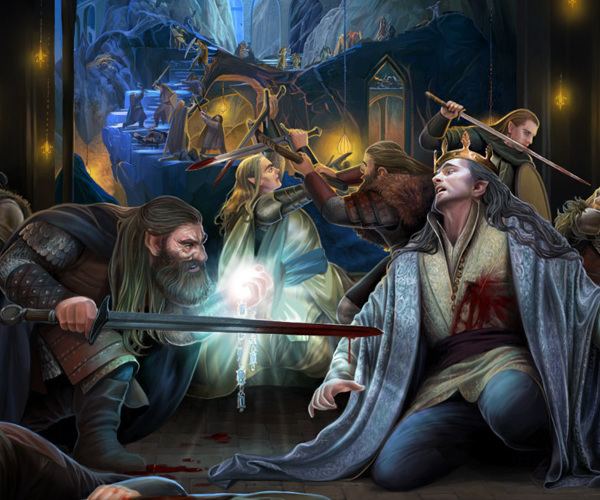
Elrond, at his Council, makes comparison to the Last Alliance of Elves and Men of the Second Age in The Lord of the Rings saying,
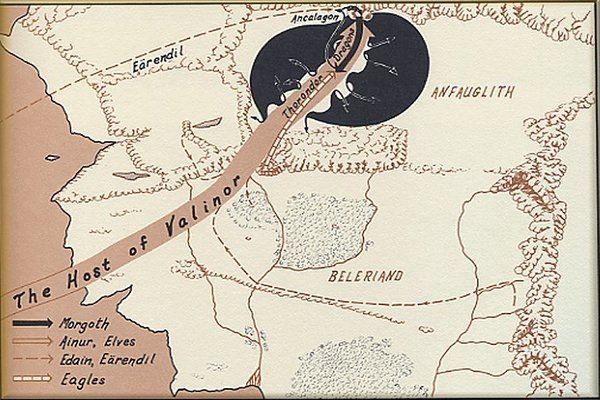
I remember well the splendour of their banners ... It recalled to me the glory of the Elder Days and the hosts of Beleriand, so many great princes and captains were assembled. And yet not so many, nor so fair, as when Thangorodrim was broken...
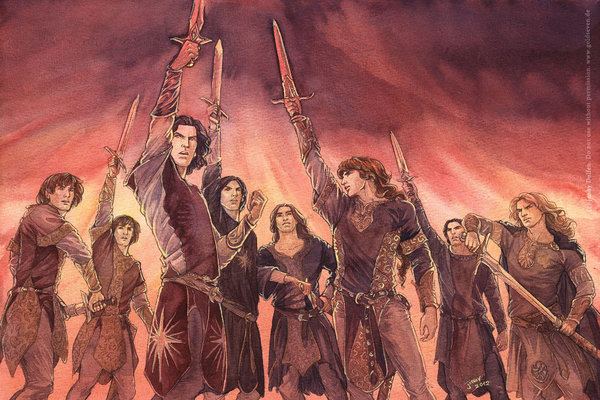
In the Tale of the Years it is called the Great Battle and the army, the Host of Valinor. The best known and most poetical account is in The Silmarillion, itself closely drawn from the earlier Quenta Silmarillion. The most detailed account of the course of the war is in The Later Annals of Beleriand. Other accounts and fragmentary details about the war are scattered, appearing in the earliest versions of the legendarium.
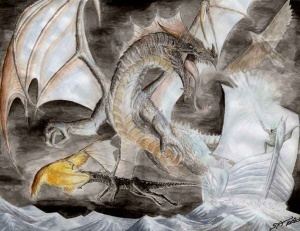
The experience of distance to the War of Wrath is greatest in Lord of the Rings, drawing nearer to it in The Silmarillion, closer still in the Annals and Quentas of the History of Middle-earth and closest, in aspects, in The Lost Tales.
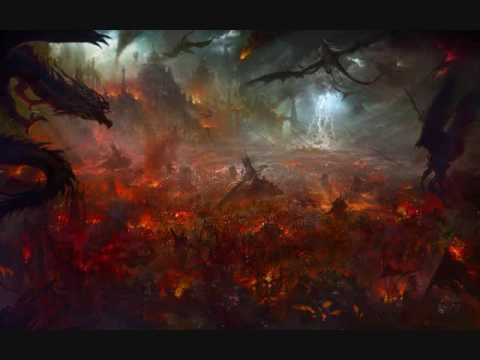
The Silmarillion account
As it is told in The Silmarillion, by the end of the five centuries after the rising of the sun, Morgoth had defeated all who opposed him and become mighty and uncontested in Middle-earth. The mariner Eärendil, by the light of the Silmaril on his brow, searches and comes to Valinor, on behalf of the two kindreds (that of Elves and Men), asking the Valar to pardon and aid the enthralled Elves and Men of Middle-earth.
The Valar are moved by Eärendil's plea and prepare a great armament. The armies of the Vanyar and the remaining Noldor are sent from Aman to Middle-earth in a mighty host. At the behest of Elwing, their kinswoman, the Teleri carry the host on their ships, but they remain on their ships for they would not land. The Host of Valinor marches through Beleriand and meets the forces of Morgoth.
The Host of the Valar completely defeats the Orc armies of Melkor and destroys most of the Balrogs. While the Three Houses of Men, the Edain, fought for the Valar, many other Easterling Men fought for Morgoth and are either destroyed or flee to the far eastern parts of Middle-earth. The Host of the Valar marches north to Angband in pursuit of the remnants of the hosts of Morgoth. There Melkor releases his last and greatest force, the fleet of winged dragons, that had never been seen before, and they drive the Host of the Valar back. Then Eärendil comes with his ship Vingilótë, along with the Eagles of Thorondor, Lord of Eagles, and there they contest with the dragons in the air, slaying most of them. Eärendil engages the mightiest of dragons, Ancalagon the Black, for twenty-four hours, until at last he throws down Ancalagon from the sky, whose fall breaks the towers of Thangorodrim, the volcanic triple-peak mountain range that Melkor had raised above the gate of Angband. Morgoth is captured and he is bound again with the chain Angainor. His iron crown is beaten into a collar, his feet are "hewn from under him", and the two Silmarils are taken by the Maia Eönwë, the herald of Manwë. Finally, the Valar imprison him in the Void behind the Door of Night.
The wreckage of the war is immense. The River Sirion is destroyed. Much of the north of the land west of the Ered Luin is laid waste and sinks into the sea. The surviving Elves of Beleriand are bidden by Eönwë to return with him to the lands of Aman. Most of them do so, but others refuse the summons and instead journey eastward where they become lords of the remaining Noldor and Sindar, as well as others in the east such as the Silvan Elves. Among these were Gil-galad, Galadriel and Celeborn, Círdan, Elrond, Celebrimbor, and Thranduil. It should be noted that Círdan was following his mission set by the Valar in the First Age and therefore the summons likely did not apply to him.
After Morgoth's defeat, those men of the Edain who fought for the host of the Valar are granted the island land of Andor. Following Elros as King, they found the realm of Númenor. Morgoth's chief servant, Sauron, surrenders to Eönwë and is summoned to Valinor to receive judgement by the Valar. However, he is unwilling to face the Valar and flees to the east, as do some Dragons, Trolls, Balrogs and Orcs to trouble the Men, Elves and Dwarves through later ages.
The History of Middle-earth accounts
The Silmarillion account closely follows the Quenta Silmarillion and is in agreement with it on the events of the war varying mostly in nomenclature.
Nearly contemporary to the Quenta Silmarillion are the Annals of Beleriand, a complementary, separate account with a different point of view. The two main versions, early and late, of the Annals are in agreement with the events but are at variance with nomenclature and dates. They provide a good deal of incidental detail otherwise lacking in the various parallel versions of the Silmarillion. The Later Annals are the final version of the War of Wrath in this form. There are versions of events and aspects of the war in the Annals that are in conflict with those in Quenta Silmarillion beyond minor inconsistencies in nomenclature and dates. Most notably, the Annals, in contrast to the Silmarillion and Quenta traditions, hold that Morgoth leaves Angband passing over Taur-na-Fuin to contest the passage of Sirion.
Other details do not conflict with the Silmarillion, because of the difference in mode between Annal and Quenta some are just not present in the Quentas. The landing of Ingwë's son and his victory in the Battle of Eglarest is a significant example. The Later Annals provide additional details about the battle including the driving of the Orcs from the shore and then entire Host of Valinor driving both Orcs and Balrogs across Sirion followed by the long struggle of the hosts of the West and North for passage of the River Sirion which lay between the Hosts.
It is only in the Annals versions and the earliest Quenta that Eönwë is stated to be leader, or captain, of the Host of the West and that Ingwion is captain of the Vanyar. In The Silmarillion, Eönwë is called 'the Herald of Manwë'. As captains, The Silmarillion mentions Finarfin leading the Noldor of Aman and Thorondor "captain of the great birds of heaven". Lay of Leithian speaks directly of Balrog captains leading Orcs:
"the Orcs went forth to rape and war, and Balrog captains marched before.".
In The Fall of Numenor, it is stated that after their defeat "... Morgoth and many of his captains were bound ...".
The Later Annals of Beleriand expand on detail and reintroduce the encampment of the Host beside the River Sirion that goes back to the earliest fragments of the story. There a camp is made in Tasarinan, Land of Willows, the place mentioned in Treebeard's song in The Two Towers, "the willow-meads of Tasarinan". Further, some subsidiary battles to the campaign of the Great Battle are mentioned there briefly, as well as in the tale of The Fall of Gondolin where the Battle of Tasarinan is described as a surprise attack by the Goblins on the Noldor of the Host. Another battle is that of the Silent Pools, or Twilight Pools which is Umboth Muilin, or Aelin-uial. Here it is suggested that the Easterling Men of Hithlum descend from the north and attack the flank of the Elves. The early traditions for this battle are in some serious contradiction at points with the later tales in that it is held here that Tulkas and Morgoth and other Valar are present whereas later only the Maiar, Eönwë for the Host of the West, sometimes with other Maiar, the sons of the Valar, and the Balrogs, for the Hosts of Angband, take the field. In The Quenta, the sons of the Valar are a separate host, captained by Fionwë/Eonwë, from the host of the elves that accompany them.
Throughout all the varied stories and time the terrain over which the War of Wrath is fought remains remarkably the same, in particular, the River Sirion. The course of the river is never changed on the maps and its character stays consistent. It is the mighty river that divides East and West Beleriand. As early as the Lays of Beleriand until the Children of Húrin it is described as uncrossable on foot except at a very few places: far north at Eithel Sirion, at the ford of the Brithiach, over the Guarded Bridge near the tributary Esgalduin and below the tributary River Aros, south of the impassable Marshes of Sirion was the land bridge of the Andram, three leagues wide, above the Gates of Sirion. This makes Sirion a formidable obstacle to an army trying to cross it in the face of opposition. Without the further use of the ships of the Telerin fleet the Host of the Valar cannot be ferried to East Beleriand flanking the line of Sirion in the south but must fight their way across at one or more of those crossings. Advancing north west of Sirion does not allow a northern flanking of the line of Sirion as there is only a ford near Eithel Sirion and only a couple of easily defended and widely separated passes through the mountains of Ered Wethrin. This explains the extended deadlocked conflict, particularly the long and bitterly contested passage of Sirion, between Eönwë leading the Host of the West and Morgoth's Host of the North described in the Annals and the Tale of the Years as lasting over forty years. The Later Annals Beleriand state: "This war lasted fifty years from the landing of Fionwë." It is not mentioned how Beleriand was destroyed and sunk in the fighting, only that the cataclysmic engagements between Morgoth's hosts and the Valarian hosts caused the earth to shake and fissure: "The entire North was aflame with war."
In the aftermath of Morgoth's overthrow and the wrack of Beleriand, Eonwë and the Host of the Valar return with the exiled Noldor and many of the surviving Sindar in a fleet built to carry them. It is stated in the Quenta and Quenta Silmarillion that the Elves of the Vanyar march back separately to Valinor, led by Ingwë's son. Following the end of the First Age the surviving men of the Edain, under the leadership of Elros, and the guidance of Círdan, build a fleet of some 150 to 300 ships that over the next 50 years bring 5,000 to 10,000 people to Númenor.
Impact on popular culture
There are several musical adaptations taken from the War of Wrath:
